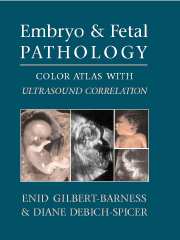Book contents
- Frontmatter
- Contents
- Foreword by John M. Opitz
- Preface
- Acknowledgments
- 1 The Human Embryo and Embryonic Growth Disorganization
- 2 Late Fetal Death, Stillbirth, and Neonatal Death
- 3 Fetal Autopsy
- 4 Ultrasound of Embryo and Fetus: General Principles
- 5 Abnormalities of Placenta
- 6 Chromosomal Abnormalities in the Embryo and Fetus
- 7 Terminology of Errors of Morphogenesis
- 8 Malformation Syndromes
- 9 Dysplasias
- 10 Disruptions and Amnion Rupture Sequence
- 11 Intrauterine Growth Retardation
- 12 Fetal Hydrops and Cystic Hygroma
- 13 Central Nervous System Defects
- 14 Craniofacial Defects
- 15 Skeletal Abnormalities
- 16 Cardiovascular System Defects
- 17 Respiratory System
- 18 Gastrointestinal Tract and Liver
- 19 Genito-Urinary System
- 20 Congenital Tumors
- 21 Fetal and Neonatal Skin Disorders
- 22 Intrauterine Infection
- 23 Multiple Gestations and Conjoined Twins
- 24 Metabolic Diseases
- Appendices
- Index
2 - Late Fetal Death, Stillbirth, and Neonatal Death
Published online by Cambridge University Press: 23 February 2010
- Frontmatter
- Contents
- Foreword by John M. Opitz
- Preface
- Acknowledgments
- 1 The Human Embryo and Embryonic Growth Disorganization
- 2 Late Fetal Death, Stillbirth, and Neonatal Death
- 3 Fetal Autopsy
- 4 Ultrasound of Embryo and Fetus: General Principles
- 5 Abnormalities of Placenta
- 6 Chromosomal Abnormalities in the Embryo and Fetus
- 7 Terminology of Errors of Morphogenesis
- 8 Malformation Syndromes
- 9 Dysplasias
- 10 Disruptions and Amnion Rupture Sequence
- 11 Intrauterine Growth Retardation
- 12 Fetal Hydrops and Cystic Hygroma
- 13 Central Nervous System Defects
- 14 Craniofacial Defects
- 15 Skeletal Abnormalities
- 16 Cardiovascular System Defects
- 17 Respiratory System
- 18 Gastrointestinal Tract and Liver
- 19 Genito-Urinary System
- 20 Congenital Tumors
- 21 Fetal and Neonatal Skin Disorders
- 22 Intrauterine Infection
- 23 Multiple Gestations and Conjoined Twins
- 24 Metabolic Diseases
- Appendices
- Index
Summary
Stillbirth or fetal death is the delivery of an infant with no signs of life between 20 weeks gestational age and term. The infant does not breathe or show any evidence of life: heart beat, pulsation of the umbilical cord, or definitemovement of voluntary muscles.
Perinatal death includes stillbirths and early neonatal deaths (less than 7 completed days from birth) (Tables 2.1 and 2.2). World Health Organization national statistics include fetal deaths with a fetus weighing 500 g or more, or gestation > 22 weeks, or crown-heel length > 25 cm. International statistics include fetal deaths with a fetus weighing > 1,000 g, gestation > 28 weeks, or crown-heel length > 35 cm.
Late intrauterine fetal death with stillbirth accounts for 1% of pregnancies.
PLACENTAL ABNORMALITIES ASSOCIATED WITH LATE FETAL DEATH
Umbilical Cord
■ Cord accidents comprise 15-18% of fetal demise.
■ Long cord – entanglement around a fetal part, cord prolapse, cord compression, true knots, and excessive spiraling (sometimes may be a postmortem artifact) (Figure 2.1).
■ Short cord may indicate a central nervous system abnormality; it is more frequent with congenital anomalies. Delay in completion of the second stage of labor, abruption, inversion of the uterus, or cord rupture at delivery may be complications (Figures 2.2 to 2.4).
■ Nuchal cord may cause fetal strangulation – functionally significant if two or more loops are around the neck, with associated plethora of the face and scalp.
[…]
- Type
- Chapter
- Information
- Embryo and Fetal PathologyColor Atlas with Ultrasound Correlation, pp. 23 - 44Publisher: Cambridge University PressPrint publication year: 2004

